| 1 | Plains garter snake |
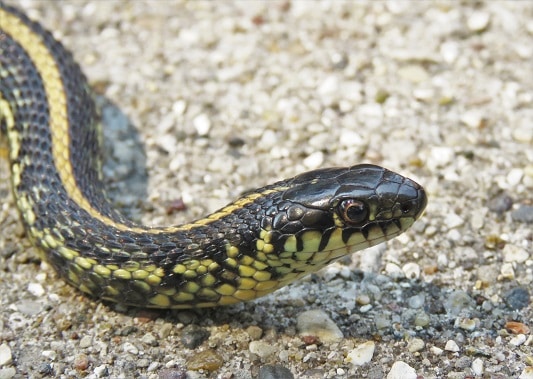
The most colourful of Canada’s 6 garter snakes, this species occupies not just a small territory near the border, but a large swathe of land stretching deep into Alberta, Manitoba and Saskatchewan. Plains garter snakes measure 90cm (maximum 109.3cm) and have a black head, with a yellow chin that extends from a yellow belly.
The plains garter snake is a moisture-loving species. It’s a flexible snake, even appearing in urban areas within towns, such as vacant lots with scattered rubbish. Nevertheless, their favourite areas are easily grassy fields and plains directly adjacent to water bodies. Plains garter snakes cannot cope with bone dry habitats, and are often spotted hunting along the overgrown edges of streams and ponds. Their diet consists of 85% frogs and toads, with two favourites being the wood frog and boreal chorus frog.
The signature way to identify this snake is an orange to yellow stripe running down the centre of its back. This contrasts vividly with the black on either side, and its flanks also have a yellow stripe apiece.
Plains garter snakes are one of Canada’s least endangered reptiles. Scientists have found that when living side by side with common garter snakes, plains garter snakes are superior at keeping a high body temperature.
| 2 | Eastern massasauga |
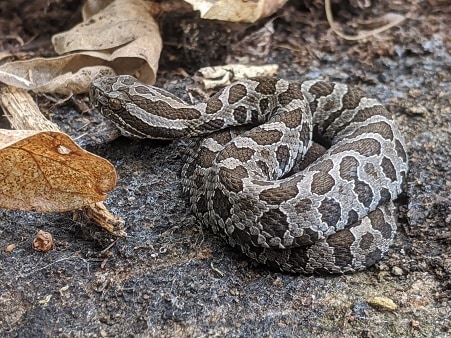
The only venomous snake eastern Canadians need to worry about. Canada has three rattlesnakes, but the prairie and Pacific rattlesnakes are found significantly further west. Meanwhile, the massasauga is found in populous Ontario, in the peninsular area bordered by Michigan and the Great Lakes.
Massassaugas measure only 60-75cm, with a record of 100.3cm, and are easy to miss on a weekend stomp through the countryside. Their venom is mainly cytotoxic, attacking and dissolving skin cells. The venom is potent enough to partially digest mouse prey before even swallowing them.
That said, the massasauga has only killed two people in Ontario. Both were over 40 years ago, and neither received antivenom. The main risk is hiking through tightly vegetated areas with poor visibility. Massasaugas have no wish to harm human beings, but will quickly shift into an aggressive state if brushed past or stepped on.
For most of the year, massasaugas favour marshes, swamps, wet prairies and lakesides, but in the drier summer months, they move to grasslands adjacent to these water bodies. These habitats are gradually being destroyed, and the massasauga is now listed as threatened under Ontario’s Endangered Species Act.
| 3 | Common garter snake |
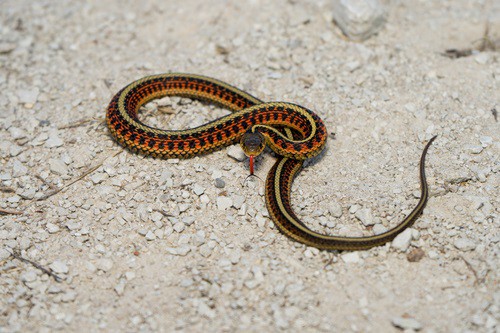
The most widespread snake in Canada, with the plains garter snake ranking in second. This species is medium length, reaching a maximum of 137.2cm. Common garter snakes (Thamnophis sirtalis) can live just about anywhere as long as a water body is nearby, including forests, shrublands, fields and wetlands.
Things are confusing with this garter snake, as the amount of subspecies is endless. There’s the eastern, red-sided, valley garter snake and more, but while superficially different, these are still technically part of the common garter snake species. The plains garter snake and terrestrial garter snake, meanwhile, are separate species altogether.
Thamnophis sirtalis has the lowest temperature tolerance of any North American snake, and there are even rumours of sightings in Alaska. They dig their dens below the frost line, and hibernate in communal burrows with dozens of fellow species members, in order to preserve warmth. The record den contained 8000 snakes. Likewise, males will dogpile females when mating, forming breeding balls of up to 100 snakes.
In Canada, the most common subspecies is the red-sided garter snake (Thamnhopis sirtalus parietalis), which extends all the way to British Columbia. This is one of the most fabulously patterned subspecies, as the red stands out vividly against the black, and some even have electric blue stripes.
| 4 | Smooth green snake |
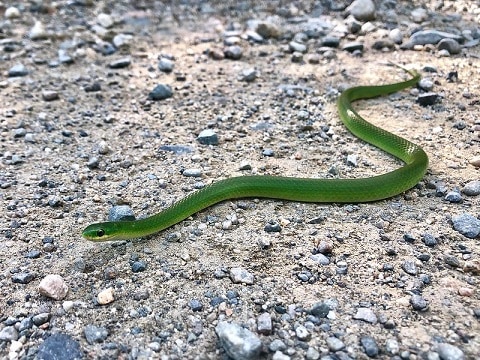
An extremely green snake, which lives in extremely green environments. Only someone with cyborg vision could spot this 30-60cm (record 79.7cm) snake while resting in a field of overgrown grass.
Smooth green snakes have a decent range in Canada, occupying southern Ontario and Quebec. They favour not just grassy areas, but moist, herbaceous grassy areas with an overload of vegetation. They sometimes appear on the edges of marshes too. Their lookalike cousin is the rough green snake (Opheodrys aestivus), but this inhabits the southeastern US, whereas smooth green snakes (Opheodrys vernalis) live significantly further north – hence why they cross into Canada.
This snake has one of the most insect-rich diets, as one study discovered a menu of 37% caterpillars, 32% spiders, and 20% grasshoppers. Smooth green snakes are non-venomous, and incapable of hurting a human being even if picked up. This is a lazy snake which moves an average of 10 metres per day.
The smooth green snake hardly ever climbs trees, preferring to stick to the safety of overgrown grass. While widespread, they’re believed to be vulnerable to the march of agriculture. Insecticides are a grave danger, as they poison their main food supply. But hope remains, as in 2016, a survey was launched to rediscover them on Prince Edward Island in eastern Canada. Smooth green snakes were originally one of three native snakes there, alongside common garters and northern redbellies, but hadn’t been seen in 15 years. Thankfully, a rash of sightings came in from citizens, using an app called P.E.I. Nature Tracker.
| 5 | Sharp-tailed snake |
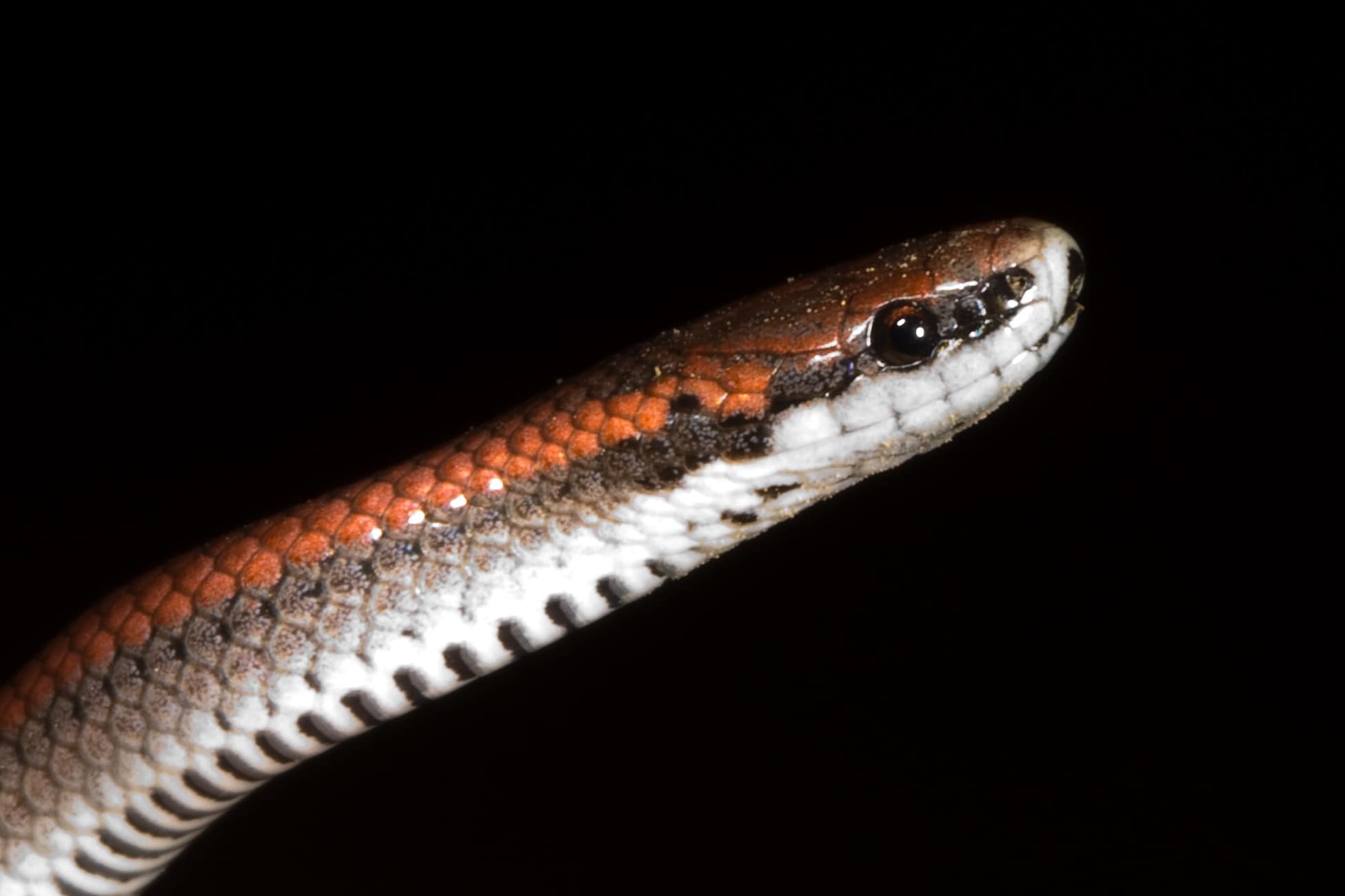
An ultra rare snake that lives solely in British Columbia. The sharp-tailed snake is non-venomous, and thin like a pencil. Their maximum length is 48.3cm, with newborns a miniscule 6-7cm. Their signature sharp tail is designed for hunting, allowing them to skewer slimy slugs like a kebab.
Sharp-tailed snakes are considered to be in mortal peril in Canada, but some believe that they’re more common than people realise. The crux is their shy personalities. Sharp-tailed snakes live on forest floors covered with mulch, debris and fallen leaves, where they burrow into underground chambers below and emerge to feed on slugs.
In Canada, they rely on one specific forest type: coastal Douglas-fir forests, ever more of which is being cut down. Many of the remaining patches are no more than 3km wide. One of their bases was Vancouver Island, but this heavily populated island now has only 0.5% of its original Douglas-fir forest cover remaining. The situation seemed grim.
In 2011 though, scientists were searching for rubber boas along a forested ridge near Pemberton, which had been targeted by builders for development. Instead, they came across 10 small sharp-tailed snakes. A new colony had been discovered, and this raised the question of how many more undiscovered colonies there are. Compared to a rattler, the sharp-tailed snake’s shy personality makes it very easy for them to go undetected.
| 6 | Prairie rattlesnake |
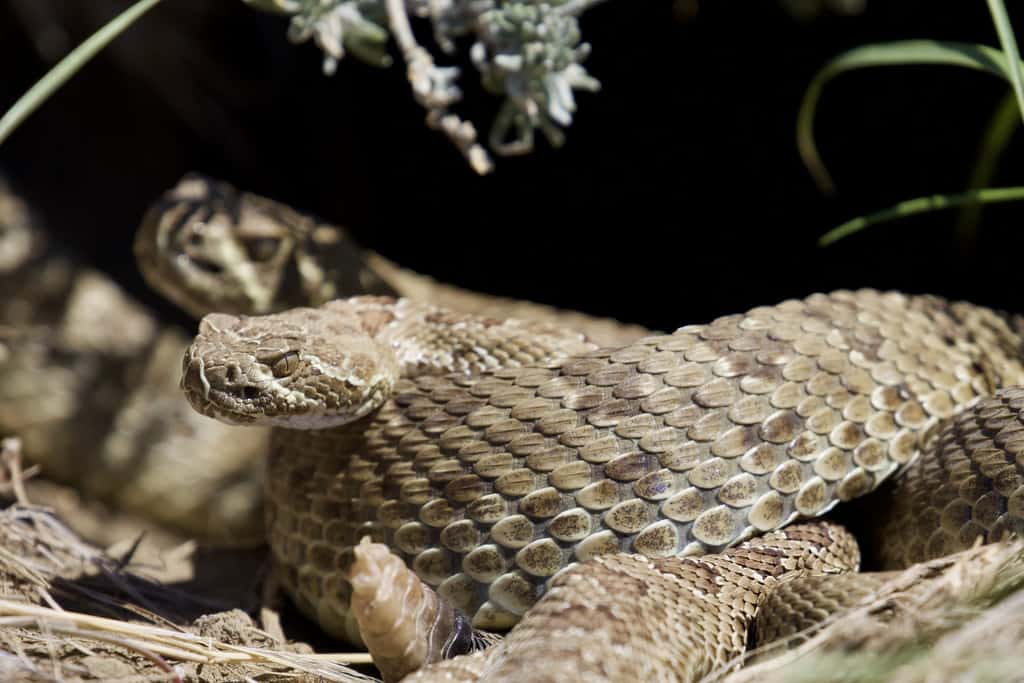
The rattlesnake of southern Saskatchewan and southeastern Alberta, prairie rattlesnakes inhabit a swathe of the mid-western US, but also spill over the northern border for several hundred miles. They prefer wide open, sweeping terrain like short grasslands and prairies (duh), usually avoiding forests.
Their venom is middling for a rattlesnake, but significantly stronger than the massasauga. Prairie rattlesnake venom changes with age; youngsters possess more metalloproteases, which cause blood vessels to burst, but adults accumulate more muscle-attacking myotoxins. This is one of the paler rattlesnakes, with a medium length, as the longest ever measured 151.5cm.
There’s estimated to be 22,300 prairie rattlesnakes living in Canada today. Nevertheless, their habitat is shrinking, particularly their open sandy prairies. A problem is that prairie rattlesnakes are the opposite of stationary; they love to make long migrations away from their winter dens, to summer feeding grounds, meaning that they need plenty of open space.
Prairie rattlesnakes have the cool feature of returning to the same winter den each year, always remembering its location. Over the last 3 decades, there have been less than 10 prairie rattlesnake bites in Alberta. However, a girl was sent to hospital in 2015, after being bitten in the rugged Alberta badlands region, a hotbed of dinosaur fossils. All she was doing was walking through a campsite.
| 7 | Eastern milksnake |
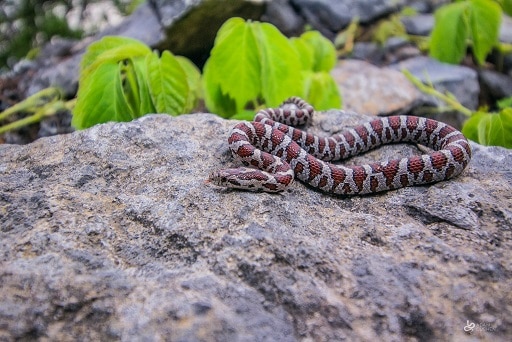
A subspecies of the milk snake found all over the United States. This is a harmless snake which lacks any venom, and hunts via crushing constriction instead. Eastern milksnakes begin life with red and black bands, but gradually become duller with age.
Eastern milksnakes (Lampropeltis triangulum triangulum) are most common in areas with plenty of forests, but also grassy meadows and clearings which they can move to to control their body temperature. They cope fairly well with human buildings, and sometimes appear in crumbling foundations or old basements. Away from forests, they require cover objects to survive, such as rotting logs or sheet metal.
The eastern milksnake is under some pressure from habitat loss, particularly in southwest Ontario, where 90% of original forest cover has been converted to heavy agriculture, and 72% of wetland. Nevertheless, there’s still estimated to be 10,000 eastern milk snakes inhabiting Canada.
Their main realm is Ontario and southern Quebec, but eastern milk snakes may reach further north than people realise, as there are scattered, mysterious records from the northern shores of Lake Heron and Lake Nipissing. Their main limit to northward migration is their eggs, which require incubation at 24C for 50-70 days. Maximum length: 132.1cm.
| 8 | Terrestrial garter snake |

Another fully independent garter snake species. The terrestrial garter snake (Thamnophis elegans) is common on Vancouver Island, as well as in western regions like British Columbia and Alberta. This snake can be difficult to identify, as its base colour varies from beige-grey to almost black, sometimes with red patches between. However, a consistent feature is a bright yellow line running down its back.
Like all garter snakes, this species lacks traditional front fang venom, and cannot kill a human. However, Thamnophis elegans does possess a mildly venomous saliva, with myotoxins that wreak havoc on the muscles of mice.
Terrestrial garter snakes often take to ponds and streams to hunt down fish, but eat more mammals than the average garter snake. In one study, their favourite was crayfish, making up 56.2% of prey, yet they’re also keen on slugs and the Townsend’s vole. This is also a rare garter snake to constrict its prey.
The record length of this species was 109.2cm, and they reach unusually high altitudes. Terrestrial garter snakes are immune to the troubles of thinning air; they just slither and slither upwards until they reach as high as 3900 metres. It’s not surprising that another of its names is the wandering garter snake. That said, this species extends less further north into Canada compared to the plains and common garter snake.
| 9 | Western hognose snake |
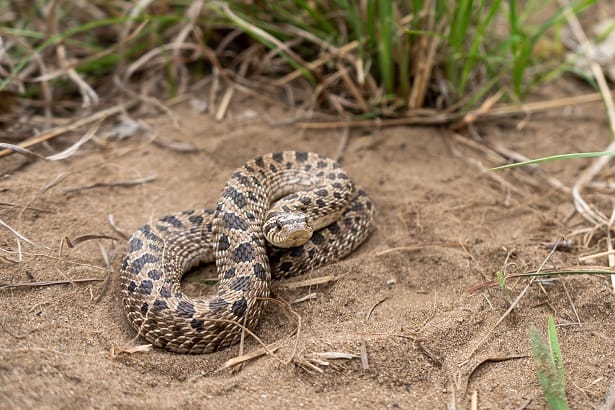
A common snake in the USA, but endangered in Canada. The western hognose snake (Heterodon nasicus) appears in short grasslands and prairies, and particularly inland sandy areas. The Spirit Sands 118 miles west of Winnipeg are one of their Canadian capitals.
Western hognose snakes average at 50cm, with an all-time record of 100.6cm. They’re named for their upturned snout, which is used for digging in soft sands. This snake has a mild venom, which is only capable of swelling a finger at worst. One of their freaky characteristics is diet-adapted adrenal glands; when they swallow American toads and the lethal bufotoxins they contain, they release a burst of adrenaline to counteract the decreased heart rate.
On most maps, western hognose snakes occupy a decent chunk of western Canada, primarily in Alberta and Saskatchewan. The problem is that their range is discontinuous, divided into several subpopulations which don’t interact and replenish each other.
One hotspot lies in Grasslands National Park, and this is 190km from the western Saskatchewan subpopulation. In Alberta, the northern and southern subpopulations are separated by 60km. Again, the gradual erosion of its wide, sweeping natural habitat is to blame.
| 10 | Bull snake |
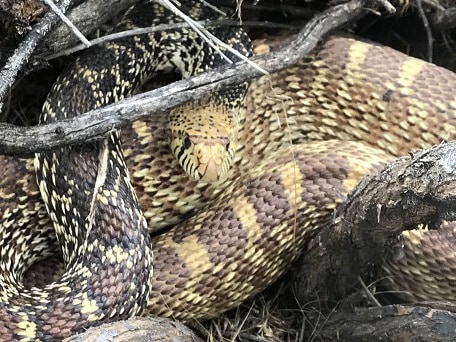
The range of the bullsnake stretches from the southern tip of Texas, to a decent way into Alberta and Saskatchewan. This is one of 7 subspecies (Pituophis catenifer sayi) of the gopher snake, and the one with the most massive range. They’re thinner than the main gopher snake, but more aggressive, and have brighter colours.
With a max length of 267.7cm, the bull snake is the longest snake in western Canada, and the USA. Bull snakes are excellent constrictors, and most of their prey is rodents. Like the main gopher snake subspecies, they’re common in crop fields, which act as magnets and draw in bullsnakes from far and wide, seeking to feed on the pests there. Some Alberta farmers have even been known to pick up bullsnakes and relocate them to particular rodent hotspots.
The bull snake is non-venomous, and its first move when threatened is to stay absolutely still, not bite. The Red Deer river area is one of their hotspots within Alberta, while in Saskatchewan, the south Saskatchewan river is their northern limit.
Bull snakes look vaguely similar to rattlesnakes, and are believed to be imitating them in a survival strategy. The rattling style is one difference, as rattlesnakes raise their tail into the air and shake segmented scales together, while bullsnakes keep their tail low and vibrate against leaves to create a fake rattle.
